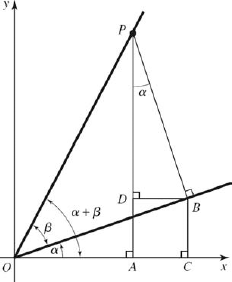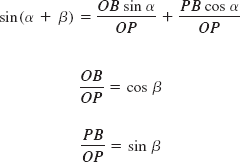16.2. Sum or Difference of Two Angles
Having established the fundamental trignometric identities, let us now move on to others that are very useful in technical work, starting with the trig functions of the sum or difference of two angles.
We now wish to derive a formula for the sine of the sum of two angles, for example, sin(α + β).
▪ Exploration:
Try this. Use your calculator to evaluate
- sin 20° sin 30° sin 50°
Does the sum of sin 20° and sin 30° equal the sine of 50°?
NOTE
The sine of the sum of two angles is not the sum of the sine of each angle.
- sin (α + β) ≠ sin α + sin β
We will show that
- sin(α + β) = sin α cos β + cos α sin β
We start by drawing two positive acute angles, α and β (Fig. 16-6), small enough so that their sum (α + β) is also acute. From any point P on the terminal side of β we draw perpendicular AP to the x axis and draw perpendicular BP to line OB. Since the angle between two lines equals the angle between the perpendiculars to those two lines (can you demonstrate that this is true?), we note that angle APB is equal to α.
Then

Figure 16.6. FIGURE 16-6

But in triangle OBC,
- BC = OB sin α
and in triangle PBD,
- PD = PB cos α
Substituting, we obtain

But in triangle ...
Get Technical Mathematics, Sixth Edition now with the O’Reilly learning platform.
O’Reilly members experience books, live events, courses curated by job role, and more from O’Reilly and nearly 200 top publishers.

